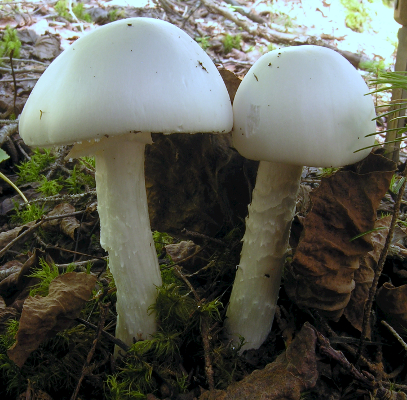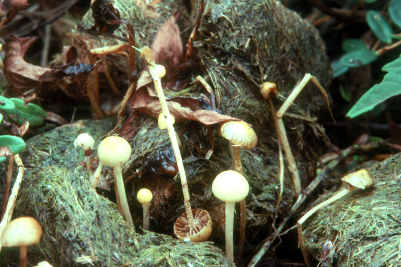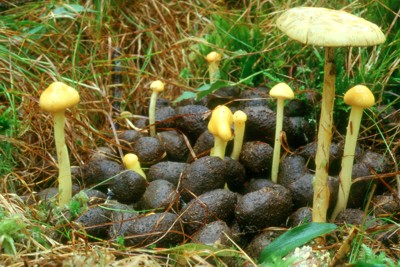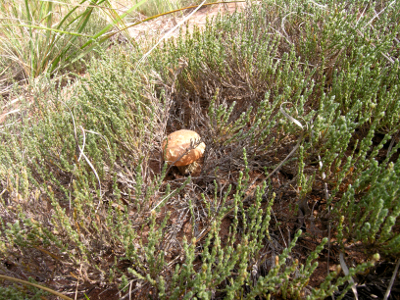MUSHROOM HABITATS
Mushrooms are found in a great variety of habitats, although each species may limited in the number of these it can occupy. For example, a mushroom that usually grows on rotting logs in the forest is unlikely to be found in sand dunes. This is one of the great appeals of mushroom hunting: visit a habitat new to you and you will probably find species of mushrooms you have never seen.
Most species of mushrooms are either saprotrophs, consumers of dead organic substances, or ectomycorrhizal, living symbiotically with the roots of living woody plants. At first you may not really know which mode of nutrition a mushroom utilizes, but there are some rules of thumb that may help with this. Large mushrooms arising from forest soil are likely to be ectomycorrhizal, at least in temperate or northern forests, while small ones found on decaying leaves or on wood are more likely to be saprotrophs. Members of the large genera Amanita, Cortinarius, Hebeloma, Hygrophorus, Inocybe, Lactarius, Russula, Tricholoma, and nearly all boletes are ectomycorrhizal, while species of Collybia, Coprinellus, Coprinopsis, Coprinus, Gymnopus, Hygrocybe, Mycena, Psathyrella, etc. are all saprotrophs.

The means fungi use to obtain their nutrition is often a great aid to their identification, so much so that lack of such information may result in misidentification. For example, Leucoagaricus leucothites, a white mushroom commonly found in lawns and open fields is easily confused by inexperienced or careless collectors with Amanita bisporigera, figured at left. Leucoagaricus leucothites is collected and eaten by enthusiastic (or perhaps over-enthusiastic) mushroom hunters while the Amanita is deadly poisonous, so a mistake in identification can be disastrous. The mistake might be avoided right away by the knowledge that A. bisporigera is ectomycorrhizal while L. leucothites is a saprotroph. If the field or lawn has nearby trees the mushroom should not be eaten.


Another example of nutritional specialization is in the closely-related species Stropharia alcis and S. semiglobata. Although the two species are very similar in the field, S. alcis, near right, normally grows on moose, elk and deer dung while S. semiglobata, far right, is usually found on the dung of horses. Collectors of these and other coprophilous (dung-inhabiting) species should always try to identify the type of dung.
When collecting mushrooms for drying and later study is is crucial to record its substrate (what it is growing on) was well as its habitat and associated trees. If it is on wood you should try to identify what kind of wood, or at least whether it is from a conifer or a hardwood. A small piece of the wood included with the collection will allow someone to identify it later using a microscope. If the mushroom is on leaves or small stems it is again helpful or even essential to know what kinds. Again, a little piece of substrate may be really helpful later. Photographs including the substrate may be useful.

Ectomycorrhizal mushrooms will always appear in association with woody plants, especially trees. However, some small shrubs and creeping woody plants may also form ectomycorrhizae with mushrooms. When collecting on sand dunes you will have to watch for willows, bearberry and some members of the Cistaceae, all of which form these associations with fungi. The photo at left shows the bolete Leccinum arenarium growing on a sand dune in Prince Edward Island among plants of Hudsonia tomentosa, a member of this Cistaceae common in such habitats. Because most mushrooms are at least somewhat selective about the tree they will associate with it is necessary to note which woody plants are near the mushroom you are collecting. I keep track of this by including a leaf of each plant species with the collection until I have time to record it in my notes. Not all woody plants are capable of forming ectomycorrhizae with mushrooms. In our forests maple, ash, cedar and a few other trees are non-ectomycorrhizal, but in tropical areas most trees lack ectomycorrhizae. Since more than one species of tree is likely to be present where you make your collection you may not be able to pin down the likely ectomycorrhizal partner and will just have to record what is present.